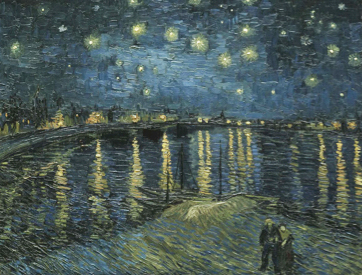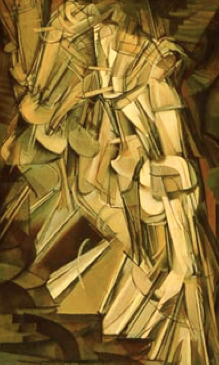Return to Series Table of Content / Return to VJIC Table of Content
“Don’t try to understand [being]. You can know it only when the mind is still. When you are present, when your attention is fully and intensely in the Now…”
…. Eckhart Tolle
There’s a link between science and art. When science penetrates too far into reality where a human mind can’t comprehend what’s going on, art tries to march forward into the unknowable. One of the topics beyond the reach of common sense is time. To many of our most powerful and well-known thinkers and scientists, time doesn’t pass at all, there is only “now.” From Buddha to Einstein, the concept of time is so clear to them but totally baffling to us. How can there be only now? It’s so obvious that time has passed since you started reading this article.
Interestingly, the fields of artistic painting and photography are wont to deal with this topic. Powerfully capturing a decisive moment in a single frame is the talent that separates artist from the novice practitioner.

© Roberto Muffoletto
For example, the photograph taken by Roberto Muffoletto captures a range of “now” for various people. The lady in the foreground seems preoccupied, possibly contemplating a range of past experiences and a projected future that may be somewhat distasteful to her. She has synthesized these experiences and projections in the “now” which shows clearly in her facial expression. The main subject, looking straight at us, appears to be fully in the moment, likely focusing on the camera. No past or future showing in his expression. But do any of the subjects pictured here have an accurate perception of time? Can they trust their “experience?”
According to Albert Einstein “…people like us who believe in physics know that the distinction between the past, the present and the future is only a stubbornly persistent illusion.” For him, the classical understanding of time began to fall apart with his insight on relativity. In that breakthrough theory, time is just another dimension like up/down; backward/forward; and, left/right. And it’s not constant—the speed of time’s passage that affects us depends on the impact of motion and gravity. And, just what did he mean by “time’s passage” if there is only “now”?
Uncle Albert and the many scientists in his camp on this topic describe something called “the block universe.” One way to come to grips with this idea is to ask, ‘does time pass…or do we pass through an existing field that we call time?’ In the latter scenario everything that ever happened, everything that is happening now, and everything that ever will happen is all laid out in one interconnected landscape of “now.” The dinosaurs are there, as well as the asteroid that ended them. The best and the worst moments of our lives still exist in this block universe. And that alien invasion (or whatever will happen in the future) is there too. It’s like an old vinyl record—the stylus intersects the groove causing awareness of the vibrations stimulated at that specific point—but the whole record and all its grooves still exist at one time in spite of the fact that our attention is riveted to just one spot. (For those too young to remember vinyl records, think of the laser of a CD player interacting with the pits on a disk. And, if you’re too young for that, you’ll have to develop your own metaphor).
A British physicist, Julian Barbour, largely agrees with Einstein’s view of time. However, he has articulated another way to look at why we perceive (or misperceive) time as we do. His ideas are based on the assumption that there is no framework to the universe. He describes motion and the perceived passage of time as being “background independent.” According to Barbour “Time is a measure of difference between two configurations.” Therefore, it’s not so much that time passes, but rather that things change. A reasonable metaphor is a movie. The film proceeds one frame at a time—each succeeding frame changed slightly. Yet the whole film (all of the frames) exists at one time, past, present and future. It’s only that our attention is drawn to each segment, one at a time, so we focus on that point rather than the whole—hence our perception that time is actually flowing in the movie.
Barbour’s theory is based, in part, on the ideas of Ernst Mach, an Austrian physicist who made significant scientific and philosophical contributions around the turn of the 19th to the 20th centuries. Mach said “It is utterly beyond our power to measure the changes of things by time. Quite the contrary, time is an abstraction, at which we arrive by means of the changes of things.”
Artist and photographer Michael Michmayr seems to capture the essence of Barbour’s time. Interestingly a primary theme in Michael Michlmayr’s photography is time. And, very interestingly, he likes to portray time as being non-sequential. This not only fits Einstein’s view of time, but also his theory of relativity in which a sequence of events is not universally constant, but, rather, dependent on the relative motion of the observer. Particle physicists have also found that the smallest pieces of the universe are not bound to travel according to any established arrow of time. They move forwards and/or backwards motivated by—we know not what. And what’s even stranger is that, given Einstein’s claim that time doesn’t exist (at least not as we perceive it), our ability to visualize the quantum world seems impossible. And yet, here we have art attempting to break that barrier.

© Michael Michlmayr
Michlmayr tends to capture the idea of the “block universe” by translating its elements into a still “moment” that a viewer can begin to visualize. “My background is not in science,” Says Michael Michlmayr. “But I sense these inconsistencies about time. My idea is to disturb the time-line showing things completely together in one space. I can shift the time line by showing one individual in different spaces and then by including different individuals all moving in opposite directions.”

© Michael Michlmayr
“My environment, the urban space is he base of my artistic research. I’m collecting traces or instants of our acting and put them together differently in the way I perceive it. In “Time Spaces” space and time is transformed. Sequences of events merging into an entire units. In this way I create a kind of stage or an “illusion of time and space“.”
Michael Michlmayr comments on his photographs from his series “Time Spaces” used in this essay.
About 500 BC a Greek philosopher named Zeno of Elea intuitively sensed something was wrong with our perception of reality. He created a string of thought experiments which revealed paradoxes in our understanding of space and motion. His motion paradox involves time (or the lack of it). He used an arrow as his metaphor to show (paradoxically) that motion is impossible. Aristotle summed-up the essence of Zeno’s presentation…
“If everything when it occupies an equal space is at rest, and if that which is in locomotion is always occupying such a space at any moment, the flying arrow is therefore motionless.” [Aristotle, Physics VI:9, 239b5]
So, if you turn this around slightly and focus on time, you could say that the arrow is always contained within a single moment.

Starry Night over the Rhone, van Gogh
The Impressionist Art Movement seems to deal with this non-intuitive perception of time (at least in my opinion). The tendency to use fluid brush strokes exposes a range of experiences captured in a single moment. Shown above, the stars, the lights, the sky are diffuse, hinting at motion and time. They surround the couple (lower right), who are shown more solid regarding space and time, yet all is captured in a single frame—a moment of time.

Nude Descending a Staircase
Marcel Duchamp
Another prime example of capturing dynamics in a single frame is the work of Marcel Duchamp. His “Nude Descending a Staircase” is a more obvious example of an attempt to portray the range of motion of a single subject in a single moment.
As a capstone to this discussion of time (or lack of it) consider one of the major enigmas of modern physics called the problem of time. It’s best defined by the Wheeler-DeWitt equation which is an attempt to describe the quantum universe.

This equation has been extremely useful to quantum scientists in studying reality. However, it has a bizarre quality—it totally ignores time. “It seems to describe a completely timeless universe” (Barbour). In the immortal words of John Wheeler “The black hole teaches us that space can be crumpled like a piece of paper into an infinitesimal dot, that time can be extinguished like a blow-out flame, and that the laws of physics that we regard as ‘sacred,’ and immutable, are anything but.”
“If everything when it occupies an equal space is at rest, and if that which is in locomotion is always occupying such a space at any moment, the flying arrow is therefore motionless.” [Aristotle, Physics VI:9, 239b5]
So, if you turn this around slightly and focus on time, you could say that the arrow is always contained within a single moment.
